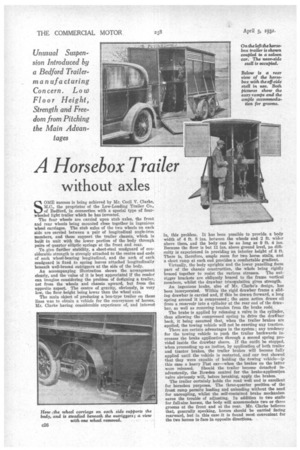A Horsebox Trailer
Page 48

If you've noticed an error in this article please click here to report it so we can fix it.
without axles
SOME success is being achieved by Mr. Cecil V. Clarke, M.C., the proprietor of the Low-Loading Trailer Co., of Bedford, in connection with a special type of fourwheeled light trailer which he has invented.
The four wheels are carded upon stub axles, the front and rear wheels being mounted close together in ingenious wheel carriages. The stub axles of the two wheels on each side are carried between a pair of longitudinal angle-iron members, and these support the trailer chassis, which is built in unit with the lower portion of the body through pairs of quarter elliptic springs at the front and rear.
To give further stability, a sheet-steel mudguard of considerable strength is strongly attached to the centre and ends of each wheel-hearing longitudinal, and the arch of each mudguard is fixed to spring leaves attached longitudinally beneath well-braced outriggers at the side of the body.
An accompanying illustration shows the arrangement dearly, and the value of it is best appreciated if the reader can imagine considering the problem of designing a trailer, not from the wheels and chassis upward, but from the opposite aspect The centre of gravity, obviously, is very low, the floor height being lower than the wheel axis.
The main object of producing a box-type trailer on these lines was to obtain a vehicle for the conveyance of horses, Mr. Clarke having considerable experience of, and interest
in, this problem. It has been possible to provide a body width of 4 ft. 8 ins, between the wheels and 2 ft. wider above them, and the body can be as long as 9 ft. 4 ins. Because the floor is but 11 ins, above ground level, no difficulty is experienced in providing an interior height of 8 ft. There is, therefore, ample room for two horse stalls, and a short ramp at each end provides a comfortable gradient.
Virtually, the body uprights and the lower panelling form part of the chassis construction, the whole being rigidly braced together to resist the various stresses. The outrigger brackets are obliquely braced th the frame vertical members, whilst the drawbar triangulation gives strength.
An ingenious brake, also of Mr. Clarke's design, has been incorporated. Within the rigid drawbar frame a sliding drawbar is carried and, if this be drawn forward, a long spring around it is compressed ; the same action draws oil from a reservoir into a cylinder at the rear end of the drawbar, as well as removing tension from the brake rods.
The brake is applied by releasing a valve in the cylinder, thus allowing the compressed spring to drive the dradtar back, it being assumed that, when the trailer brakes are applied, the towing vehicle will not be exerting any traction.
There are certain advantages in the system; any tendency for the towing vehicle to push the trailer backwards increases the brake application through a second spring provided inside the drawbar sleeve. If the outfit be stopped, when proceeding up an incline by application of both trailer and tractor brakes, the trailer brakes will become fully applied until the vehicle is restarted, and our test showed that they were capable of holding the towing vehicle--ip this ease a heavy Fiat car—when the brakes on the latter were released. Should the trailer become detached inadvertently, the Bowden control for the brake-application valve obviously will, before breaking, apply the brakes.
The trailer certainly holds the read well and is excellent for horsebox purposes. The three-quarter position of the front ramp permits loading and unloading without the need for uncoupling, whilst the self-contained brake mechanism saves the trouble of adjusting. In addition to two stalls for full-size horses, the body will accommodate two or three grooms at the front and at the rear. Mr. Clarke believes that, generally speaking, horses should be carried facing rearward, but in this ease it is found most convenient for the two horses to face in opposite directions.












































































































